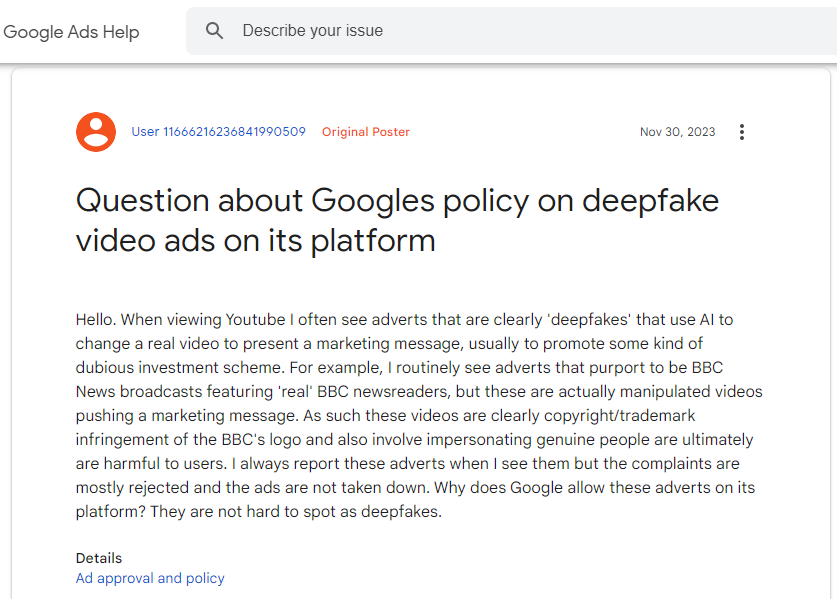Deepfakes are causing a lot of buzz these days. On one hand, they let people come up with exciting ad creatives that mix reality and fiction, pushing creative limits. On the other hand, they can raise ethical concerns and risks, as they might violate people’s rights and break platform rules, especially with a big advertising network like Google involved.
In this article, the YeezyPay team, a platform that provides access to trusted Google Ads accounts will look at how deepfakes are used in affiliate marketing – particularly on Google Ads. While we don’t promote their use and aren’t responsible for it, our aim is to explain why some affiliate marketers choose deepfakes over regular video ads and how they use them in their marketing campaigns.

Although deepfakes used to amaze audiences with their appearance, they’ve become more common now. The initial excitement may have faded, but the quality keeps improving. High-quality deepfakes can be hard to tell apart from real content, making them a powerful tool for affiliate marketers.
Here is why deepfakes are working well for affiliates:
For instance, an affiliate might create several deepfake videos with different influencers promoting a product. This way, they can quickly find out which version resonates most with their audience and make adjustments. However, it’s important to remember that Google is strict about grayhat methods. To reduce the risk of getting banned, it’s smart to use agency accounts provided by YeezyPay which are more trusted by Google Ads.
Deepfake technology allows affiliates to produce one video that can be easily adapted into different languages. This saves time and ensures the message remains consistent, increasing the chances of engaging viewers and converting them into customers.
Let’s look at a few examples of how deepfakes are being used:



Another example features Arda Güler, a football player, giving an interview where he promotes the game Sweet Bonanza.








Watch an example here and another here.
These examples show that in the right hands, deepfakes can be effective for making money with affiliate marketing. However, the question of ethics in using them is something each person must consider for themselves.
Most of these videos follow a “problem-solution” approach. This means they start by identifying a common issue that many people face. Then, a celebrity acts as a guide, showing how the product can help solve that problem. For example, a celebrity might discuss their struggles with weight loss and then introduce a diet product that works for them.
To make their claims more convincing, affiliates often include relevant statistics and data. This information helps build trust and credibility with the audience, making them more likely to consider the product.
At the end of the videos, there’s usually a strong call to action, such as “Buy now” or “Visit our site.” This encourages viewers to take immediate action, whether it’s making a purchase or exploring the product further.
To find the best converting videos, affiliates frequently test different elements, like voiceovers and calls to action. By experimenting with various combinations, they can identify what resonates best with their audience.
However, this testing can sometimes lead to problems. Ads may get disapproved, or accounts may be banned, which can be frustrating for marketers. This isn’t solely because of the use of deepfakes, but often due to the nature of the offers being promoted. Google is particularly strict about grayhat offers, meaning they don’t tolerate questionable or risky content, even if it’s just standard text and images.
To reduce risks and make the moderation process smoother, it can be helpful to use agency accounts from YeezyPay that have high trust ratings. These accounts are generally seen as more reliable by Google, which can help avoid some of the common pitfalls in advertising. Even if an account does get suspended, users can still withdraw their remaining funds immediately.

Google has been tackling deepfakes for a while now. Two years ago, they banned creating deepfakes in their Colaboratory platform, and this year, they imposed restrictions on the distribution of explicit deepfakes in search results. According to Google representative Emma Higham, these measures have reduced the number of fake nude images by over 70%. Additionally, since May of this year, promoting or advertising services that generate or distribute adult deepfakes is not allowed.
The situation is more complicated for non-adult deepfake ads. While these ads can sometimes pass moderation because the platform can’t always tell the difference between real and fake celebrities, if the deception is discovered, they may violate several platform rules, including:


So, what can affiliates do? The best strategy is to respect people’s rights and get consent from influencers before using their likeness. Taking risks can sometimes pay off, but only when those risks are sensible. It’s usually better to create something original without relying on deepfakes than to deal with potential problems later. There are many ways to make a profit in grayhat verticals without using deepfakes. Your chances of success will increase significantly if you use agency accounts that are trusted by Google and less likely to face bans.
In this article, the YeezyPay team, a platform that provides access to trusted Google Ads accounts will look at how deepfakes are used in affiliate marketing – particularly on Google Ads. While we don’t promote their use and aren’t responsible for it, our aim is to explain why some affiliate marketers choose deepfakes over regular video ads and how they use them in their marketing campaigns.
What are deepfakes?
At their core, deepfakes are media content created using artificial intelligence (AI) and machine learning. These technologies can mimic the looks and voices of real people, producing very realistic fake images, videos, and audio.Although deepfakes used to amaze audiences with their appearance, they’ve become more common now. The initial excitement may have faded, but the quality keeps improving. High-quality deepfakes can be hard to tell apart from real content, making them a powerful tool for affiliate marketers.
What are the benefits of using deepfakes in affiliate marketing?
Google Ads is a reliable source of quality traffic, but getting good results from ad campaigns takes effort. To make a profit, affiliates need to constantly optimize their ad campaigns and use smart strategies that generate sales and conversions. One strategy that some affiliates are starting to use is deepfake technology.Here is why deepfakes are working well for affiliates:
- They help to create memorable video ads
- The importance of testing
For instance, an affiliate might create several deepfake videos with different influencers promoting a product. This way, they can quickly find out which version resonates most with their audience and make adjustments. However, it’s important to remember that Google is strict about grayhat methods. To reduce the risk of getting banned, it’s smart to use agency accounts provided by YeezyPay which are more trusted by Google Ads.
- Reaching multilingual audiences
Deepfake technology allows affiliates to produce one video that can be easily adapted into different languages. This saves time and ensures the message remains consistent, increasing the chances of engaging viewers and converting them into customers.
Deepfakes in action
Deepfakes are commonly used in verticals like gambling, cryptocurrency, and nutra. The most popular types of deepfake videos often imitate news broadcasts or feature well-known personalities. For instance, gambling and betting advertisers frequently use football players to promote their websites, while cryptocurrency advertisements might feature someone like Elon Musk. Nutra offers are often endorsed by well-respected doctors from specific countries.Let’s look at a few examples of how deepfakes are being used:
- Bitcoin promotions:
- Cristiano Ronaldo's endorsement:
Another example features Arda Güler, a football player, giving an interview where he promotes the game Sweet Bonanza.
- Elon Musk endorsing trading platforms:
- Doctor endorsements:
- Diabetes treatment:
Watch an example here and another here.
These examples show that in the right hands, deepfakes can be effective for making money with affiliate marketing. However, the question of ethics in using them is something each person must consider for themselves.
Designing/ Choosing deepfake ad creatives to use in Google Ads
In Google Ads, affiliate marketers often use clips from recent celebrity interviews and popular YouTube videos, or they take successful content from Facebook that has performed well in the past. This strategy allows them to engage viewers by leveraging familiar faces and trending topics.Most of these videos follow a “problem-solution” approach. This means they start by identifying a common issue that many people face. Then, a celebrity acts as a guide, showing how the product can help solve that problem. For example, a celebrity might discuss their struggles with weight loss and then introduce a diet product that works for them.
To make their claims more convincing, affiliates often include relevant statistics and data. This information helps build trust and credibility with the audience, making them more likely to consider the product.
At the end of the videos, there’s usually a strong call to action, such as “Buy now” or “Visit our site.” This encourages viewers to take immediate action, whether it’s making a purchase or exploring the product further.
To find the best converting videos, affiliates frequently test different elements, like voiceovers and calls to action. By experimenting with various combinations, they can identify what resonates best with their audience.
However, this testing can sometimes lead to problems. Ads may get disapproved, or accounts may be banned, which can be frustrating for marketers. This isn’t solely because of the use of deepfakes, but often due to the nature of the offers being promoted. Google is particularly strict about grayhat offers, meaning they don’t tolerate questionable or risky content, even if it’s just standard text and images.
To reduce risks and make the moderation process smoother, it can be helpful to use agency accounts from YeezyPay that have high trust ratings. These accounts are generally seen as more reliable by Google, which can help avoid some of the common pitfalls in advertising. Even if an account does get suspended, users can still withdraw their remaining funds immediately.
Why isn't everything so perfect?
While deepfakes offer exciting opportunities, there are some major downsides. One major issue is the need to obtain or purchase rights to use someone’s likeness. Using deepfakes without permission can lead to legal problems, such as:- Damaging the reputation of public figures
- Spreading false information
- Invading someone’s privacy
Google has been tackling deepfakes for a while now. Two years ago, they banned creating deepfakes in their Colaboratory platform, and this year, they imposed restrictions on the distribution of explicit deepfakes in search results. According to Google representative Emma Higham, these measures have reduced the number of fake nude images by over 70%. Additionally, since May of this year, promoting or advertising services that generate or distribute adult deepfakes is not allowed.
The situation is more complicated for non-adult deepfake ads. While these ads can sometimes pass moderation because the platform can’t always tell the difference between real and fake celebrities, if the deception is discovered, they may violate several platform rules, including:
- Ads that mislead users with false information
- Impersonating someone else or falsely claiming a connection to a celebrity or brand
- Ads that infringe on copyright or violate local laws
Conclusion
Deepfakes can definitely make advertising campaigns more engaging and increase conversions by capturing audience attention, speeding up the optimization process, and allowing for creative flexibility across different regions. However, using deepfakes carries the risk of legal issues, as they can violate privacy rights and damage reputations.So, what can affiliates do? The best strategy is to respect people’s rights and get consent from influencers before using their likeness. Taking risks can sometimes pay off, but only when those risks are sensible. It’s usually better to create something original without relying on deepfakes than to deal with potential problems later. There are many ways to make a profit in grayhat verticals without using deepfakes. Your chances of success will increase significantly if you use agency accounts that are trusted by Google and less likely to face bans.





